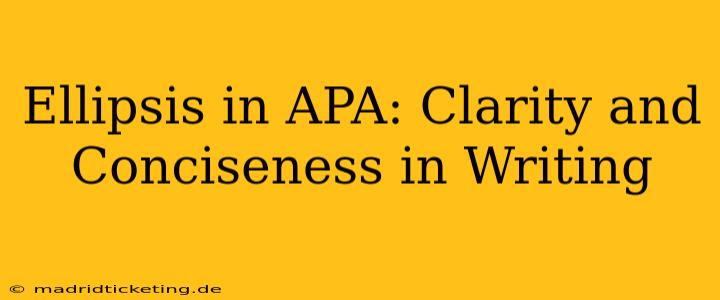The ellipsis (... ), those three seemingly insignificant dots, play a surprisingly crucial role in academic writing, especially when adhering to the American Psychological Association (APA) style guide. Mastering their correct usage is key to maintaining clarity, conciseness, and the academic integrity of your work. This guide will explore the nuances of using ellipses in APA style, providing clear examples and addressing common questions.
What is an Ellipsis and When Should I Use It in APA?
An ellipsis is used to indicate the omission of words within a quote. It's vital to remember that this omission should never alter the original meaning of the quote. In APA style, ellipses are used sparingly and only when absolutely necessary to shorten a quote without distorting its message. Overuse can make your writing appear choppy and unprofessional.
How to Use an Ellipsis Correctly in APA Style
The rules for ellipsis usage within APA style are quite specific:
-
Three dots only: Use only three periods (...) to represent omitted words within a sentence. Avoid using four dots (…), which is sometimes seen in other style guides.
-
Space before and after: Place a space before and after the ellipsis. This improves readability and differentiates it from other punctuation.
-
Beginning and end of quotes: If you omit words from the beginning or end of a quote, you do not need an ellipsis. The omission is implied.
-
Omitting a full sentence: When omitting a complete sentence, use a period followed by an ellipsis, leaving one space after the period and before the ellipsis. (….)
-
Brackets and ellipses: If you need to add words within an ellipsis to clarify the meaning, enclose those added words in square brackets [ ]. This ensures transparency and accuracy.
Examples of Correct Ellipsis Usage in APA
Here are some examples illustrating correct ellipsis usage within APA-style quotations:
Example 1 (Omitting words within a sentence):
Original quote: "The quick brown fox jumps over the lazy dog, and the playful kitten chases the ball."
Modified quote: "The quick brown fox jumps over...the playful kitten chases the ball."
Example 2 (Omitting a full sentence):
Original quote: "The experiment showed significant results. Further research is needed to confirm these findings. The data suggest a strong correlation."
Modified quote: "The experiment showed significant results. ... The data suggest a strong correlation."
Example 3 (Adding words for clarity):
Original quote: "The study participants reported feeling 'happy' and 'excited' about the results."
Modified quote: "The study participants reported feeling [very] 'happy' and 'excited' about the results..." (Note: this is an example of adding words for clarification; brackets are crucial here)
What if I Need to Omit Multiple Sentences?
When omitting multiple sentences, it's crucial to maintain the overall meaning. Use a period followed by an ellipsis (...) after each omitted sentence. Each instance where the sentence structure and flow have been changed must be indicated. Always err on the side of caution, and if you are uncertain, it’s better to include the whole quote.
Are There Any Exceptions to These Rules?
Generally, the guidelines above are consistently applied. However, some journals may have slightly different preferences; hence, always check the specific instructions of your target publication or institution.
Frequently Asked Questions about Ellipses in APA Style
Can I use an ellipsis at the beginning of a quote?
No, you should not use an ellipsis at the beginning of a quote unless you are omitting words from the start of a sentence within a longer quote. If you are starting the quote mid-sentence, do not include ellipses at the start.
Can I use an ellipsis at the end of a quote?
No, you do not need an ellipsis at the end of a quote. The omission is implied.
What if the ellipsis breaks the flow of my writing?
If the ellipsis disrupts the flow, consider whether the omission is truly necessary. Sometimes, including the full quote is a more effective and less confusing choice.
By following these guidelines, you can ensure your use of ellipses adheres to APA style, contributing to the clarity and conciseness of your academic writing. Remember, precision is paramount in academic work, and proper punctuation is a key element of that precision.

